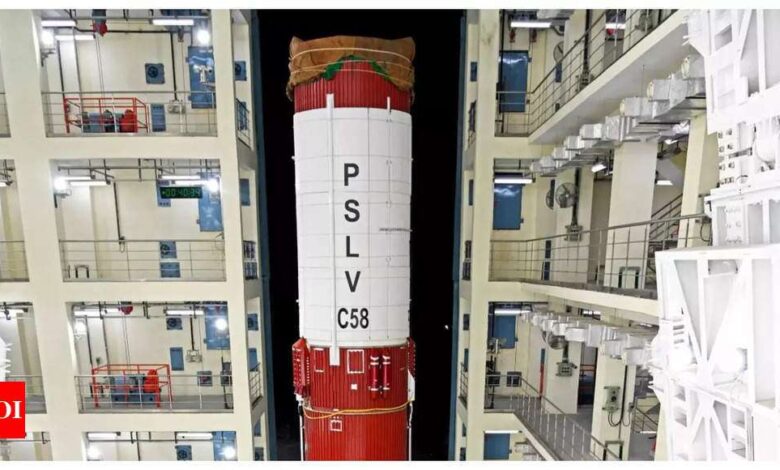India
Isro to kick off New Year with Jan 1 launch of XPoSat to study black hole, neutron stars | India News

[ad_1]
NEW DELHI: ISRO will usher in the New Year by launching X-ray Polarimeter Satellite (XPoSat), which aims to study 50 brightest sources in space, including pulsars, black hole X-ray binaries, neutron stars, and non-thermal supernova remnants, from the Sriharikota spaceport on January 1. The rocket PSLV-C58, which will carry XPoSat, will also host 10 other payloads in its last stage after injecting the main satellite into the desired orbit.
With XPoSat, India is on the verge of a groundbreaking leap in space-based X-Ray astronomy. Unlike previous missions that focused predominantly on imaging, time-domain studies, and spectroscopy, XPoSat will be India’s first dedicated polarimetry mission that aims to explore the polarisation of intense X-Ray sources, introducing a novel dimension to X-Ray astronomy, the space agency said.
X-Ray polarisation serves as a crucial diagnostic tool for examining the radiation mechanism and geometry of celestial sources.
The XPoSat spacecraft is designated for observation from Low Earth Orbit, carrying two scientific payloads. With these two payloads, the XPoSat mission is capable of simultaneous studies of temporal, spectral and polarisation features of the bright X-Ray sources.
“The primary payload, POLIX (Polarimeter Instrument in X-rays), developed by the Raman Research Institute (RRI), focuses on measuring polarimetry parameters in the medium X-ray energy range. It comprises a collimator, scatterer, and four X-ray proportional counter detectors,” Isro said.
“XSPECT (X-ray Spectroscopy and Timing), developed by the UR Rao Satellite Centre (URSC), offers fast timing and excellent spectroscopic resolution in soft X-rays. XSPECT is capable of observing various sources, including X-ray pulsars, black hole binaries, and active galactic nuclei,” Isro added.
Besides the main satellite XPoSAT, the PSLV will carry 10 more instruments to space on the last rocket stage — the PSLV Orbital Experimental Module or POEM. The five five instruments on POEM as listed by Isro are: “Radiation Shielding Experimental Module (RSEM)” to evaluate Tantalum coating effectiveness, by TakeMe2Space, Hyderabad; Women Engineered Satellite (WESAT) to compare Solar Irradiance and UV Index, by LBS Institute of Technology for Women; BeliefSat-0, an amateur radio satellite by KJ Somaiya Institute of Technology; Green Impulse TrAnsmitter (GITA), a green bipropellant CubeSat propulsion unit by Inspecity Space Labs Private Limited and Launching Expeditions for Aspiring Technologies – Technology Demonstrator (LEAP-TD) for demonstration of subsystems of microsatellite by space startup Dhruva Space.”
The other five include, two instruments from Bengaluru based firm Bellatrix Aerospace — “RUDRA 0.3 HPGP” the green monopropellant thruster and “ARKA-200”, a heater less hollow cathode for Hall thrusters — two payloads by Isro’s Vikram Sarabhai Space Centre (VSSC) and one by Physical Research Laboratory (PRL). The two VSSC instruments are “Fuel Cell Power System (FCPS)” for demonstration of fuel cell and Silicon-based high energy cell, while the PRL payload, the Dust Experiment (DEX) will measure interplanetary dust count.
With XPoSat, India is on the verge of a groundbreaking leap in space-based X-Ray astronomy. Unlike previous missions that focused predominantly on imaging, time-domain studies, and spectroscopy, XPoSat will be India’s first dedicated polarimetry mission that aims to explore the polarisation of intense X-Ray sources, introducing a novel dimension to X-Ray astronomy, the space agency said.
X-Ray polarisation serves as a crucial diagnostic tool for examining the radiation mechanism and geometry of celestial sources.
The XPoSat spacecraft is designated for observation from Low Earth Orbit, carrying two scientific payloads. With these two payloads, the XPoSat mission is capable of simultaneous studies of temporal, spectral and polarisation features of the bright X-Ray sources.
“The primary payload, POLIX (Polarimeter Instrument in X-rays), developed by the Raman Research Institute (RRI), focuses on measuring polarimetry parameters in the medium X-ray energy range. It comprises a collimator, scatterer, and four X-ray proportional counter detectors,” Isro said.
“XSPECT (X-ray Spectroscopy and Timing), developed by the UR Rao Satellite Centre (URSC), offers fast timing and excellent spectroscopic resolution in soft X-rays. XSPECT is capable of observing various sources, including X-ray pulsars, black hole binaries, and active galactic nuclei,” Isro added.
Besides the main satellite XPoSAT, the PSLV will carry 10 more instruments to space on the last rocket stage — the PSLV Orbital Experimental Module or POEM. The five five instruments on POEM as listed by Isro are: “Radiation Shielding Experimental Module (RSEM)” to evaluate Tantalum coating effectiveness, by TakeMe2Space, Hyderabad; Women Engineered Satellite (WESAT) to compare Solar Irradiance and UV Index, by LBS Institute of Technology for Women; BeliefSat-0, an amateur radio satellite by KJ Somaiya Institute of Technology; Green Impulse TrAnsmitter (GITA), a green bipropellant CubeSat propulsion unit by Inspecity Space Labs Private Limited and Launching Expeditions for Aspiring Technologies – Technology Demonstrator (LEAP-TD) for demonstration of subsystems of microsatellite by space startup Dhruva Space.”
The other five include, two instruments from Bengaluru based firm Bellatrix Aerospace — “RUDRA 0.3 HPGP” the green monopropellant thruster and “ARKA-200”, a heater less hollow cathode for Hall thrusters — two payloads by Isro’s Vikram Sarabhai Space Centre (VSSC) and one by Physical Research Laboratory (PRL). The two VSSC instruments are “Fuel Cell Power System (FCPS)” for demonstration of fuel cell and Silicon-based high energy cell, while the PRL payload, the Dust Experiment (DEX) will measure interplanetary dust count.
#Isro #kick #Year #Jan #launch #XPoSat #study #black #hole #neutron #stars #India #News






